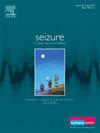Caregiver-reported non-seizure and seizure outcomes with cannabidiol and clobazam in patients aged ≥2 years with Lennox-Gastaut syndrome or Dravet syndrome: A subgroup analysis of the BECOME survey
IF 2.7
3区 医学
Q2 CLINICAL NEUROLOGY
引用次数: 0
Abstract
Purpose
This subgroup analysis of the BECOME (BEhavior, COgnition, and More with Epidiolex®) survey analyzed caregiver-reported seizure and non-seizure outcomes, including changes in caregiver burden, following cannabidiol (CBD) treatment in patients with Lennox-Gastaut syndrome (LGS) or Dravet syndrome (DS) aged ≥2 years taking concomitant clobazam, aligned with the European Medicines Agency indication.
Methods
US-based caregivers of patients with LGS/DS receiving CBD (Epidiolex®, 100 mg/mL oral solution) for ≥3 months rated patient outcome changes, comparing the previous month with pre-CBD initiation. Multiple-choice and rank-order questions with symmetrical 3-, 5-, or 7-point scales ranging from worsening to improvement were used.
Results
Patients (N = 243; 76 % LGS, 24 % DS; 52 % male; mean [range] age 15 [2–53] years) took a median of 14 mg/kg/day CBD and a median of four other antiseizure medications, including clobazam. Caregivers reported improvements in seizure frequency (87 %), severity (81 %), and weekly seizure-free days (net improvement across seizure types 68 %). Caregivers noted improvements in ≥1 question for non-seizure domains (net data across questions within each domain): alertness, cognition, and executive function (84 %); language and communication in non-verbal (81 %) and verbal (76 %) patients; emotional and social functioning (79 %); daily activities (56 %); physical functioning (44 %); and sleep (56 %). Additionally, 4–26 % of caregivers (net) reported worsening in ≥1 question in any domain. Overall, 94 % of caregivers planned to continue CBD treatment.
Conclusions
Consistent with the overall BECOME survey, most caregivers of patients with LGS/DS aged ≥2 years taking concomitant clobazam reported improvements in seizure and non-seizure outcomes since initiating CBD treatment.

护理人员报告的≥2岁lenox - gastaut综合征或Dravet综合征患者使用大麻二酚和氯巴赞的非癫痫发作和癫痫发作结果:成为调查的亚组分析
目的:根据欧洲药品管理局的适应症,对年龄≥2岁的Lennox-Gastaut综合征(LGS)或Dravet综合征(DS)患者同时服用氯巴唑,进行大麻二酚(CBD)治疗后,护理人员报告的癫痫和非癫痫结果进行亚组分析,包括护理人员负担的变化。方法LGS/DS患者接受CBD (Epidiolex®,100 mg/mL口服溶液)治疗≥3个月后,基于sus的护理人员评价患者的预后变化,并将前一个月与CBD开始前进行比较。采用从恶化到改善的对称3、5或7分制的多项选择题和顺序题。结果患者243例;76%的男性,24%的女性;52%男性;平均[范围]15岁[2-53]岁)服用CBD的中位数为14 mg/kg/天,以及其他四种抗癫痫药物的中位数,包括氯巴唑。护理人员报告了癫痫发作频率(87%)、严重程度(81%)和每周无癫痫发作天数(所有癫痫发作类型的净改善率为68%)的改善。护理人员注意到非癫痫领域的≥1个问题的改善(每个领域内问题的净数据):警觉性、认知和执行功能(84%);非语言(81%)和语言(76%)患者的语言和交流;情感和社会功能(79%);日常活动(56%);身体功能(44%);还有睡眠(56%)。此外,4 - 26%的护理人员(净)报告在任何领域中有≥1个问题恶化。总体而言,94%的护理人员计划继续进行CBD治疗。结论:与整体调查结果一致,大多数年龄≥2岁的LGS/DS患者的护理人员报告说,自开始使用CBD治疗以来,癫痫发作和非癫痫发作结果有所改善。
本文章由计算机程序翻译,如有差异,请以英文原文为准。
求助全文
约1分钟内获得全文
求助全文
来源期刊

Seizure-European Journal of Epilepsy
医学-临床神经学
CiteScore
5.60
自引率
6.70%
发文量
231
审稿时长
34 days
期刊介绍:
Seizure - European Journal of Epilepsy is an international journal owned by Epilepsy Action (the largest member led epilepsy organisation in the UK). It provides a forum for papers on all topics related to epilepsy and seizure disorders.
 求助内容:
求助内容: 应助结果提醒方式:
应助结果提醒方式:


